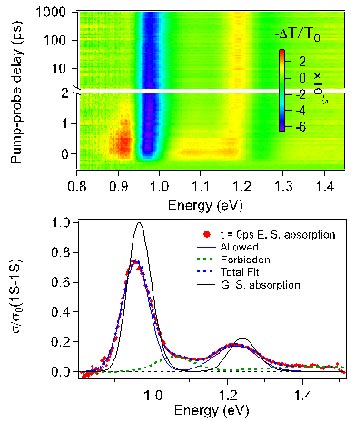Research Highlight: Quantum vs. Bulk Behavior: It Depends on the Energy
April 21, 2014

a) Raw transient absorption data (-ΔT/T0) as a function of time (pump-probe delay) and probe energy. The spectra show significant differences at early times (denoted by the circles). b) Decomposition of the excited state absorption spectrum (red dots) at t = 0 ps into allowed (blue) and forbidden transitions (green). The ground state absorption (black line) is shown for reference.
What Is The Scientific Achievement?
Semiconductor quantum dots (QDs) are nanoscale semiconductors that exhibit size dependent physical properties. For example, the color (wavelength) of light that they absorb changes dramatically as the diameter decreases. This phenomenon is due to a concept called quantum confinement and is achieved when the physical size of the QD is smaller than the size of the orbit of the electrons (represented by the electron wavefunction) in bulk forms of the material. This research project demonstrates that the size of the wavefunction of an excited electron is not static. When light is first absorbed by the electron, electrons have excess energy that effectively decreases the size of their wavefunction, which reduces the amount of confinement within the quantum dot. This can be observed by monitoring the color of light that is absorbed by the dot as a function of time. Right after photoexcitation, the absorption of wavelengths that are normally forbidden can occur due to constraints (selection rules) that are imposed by quantum confinement effects. In other words, the nanomaterials behave like bulk semiconductors rather than nanoscale quantum dots. Within a few picoseconds (ps = 10-12 s), the electrons relax, and absorption in the forbidden energy region is no longer observed.
Why Does This Matter?
Hot electron-hole pairs in QDs behave as independent charges rather than as excitons, contrary to the conventional wisdom on charge carriers in quantum confined systems. Overall, this discovery has important consequences for the use of quantum dots in optoelectronic applications, where the distinction between bulk-like and quantum dot-like (i.e. quantum confined) excitations are critically important.
What Are The Details?
- CFN Capabilities: The Advanced Optical Spectroscopy and Microscopy Facility measured the transient absorption spectra of the QDs as a function of pump photon energy.
- The team discovered that the magnitude of symmetry breaking scales with the amount of excess energy of the hot carriers, which could be exploited in device applications.
- The transient Stark effect, which is central to the observed phenomena, led to symmetry breaking in the QDs. This caused a redistribution of the optical transition strength toward dipole-forbidden transitions and a broadening of the dipole-allowed transitions during the picosecond lifetime of the hot charge carriers, evidenced in the figures.
Publication Reference
A Hot Electron−Hole Pair Breaks the Symmetry of a Semiconductor Quantum Dot
M. Tuan Trinh1, Matthew Y. Sfeir2, Joshua J. Choi1, Jonathan S. Owen1, and Xiaoyang Zhu1
1. Department of Chemistry, Columbia University, New York, NY 10027, USA
2. Center for Functional Nanomaterials, Brookhaven National Laboratory, Upton, New York 11973, USA
Nano Letters 13, 6091-6097 (2013).
Acknowledgment of Support
This work was supported by the Department of Energy under grant no. ER46673 DE-SC0001928 (to X.Y.Z.). Research was carried out in part at the Center for Functional Nanomaterials, Brookhaven National Laboratory, which is supported by the U.S. Department of Energy, Office of Basic Energy Sciences, under contract no. DE-AC02-98CH10886.
2014-4819 | INT/EXT | Newsroom











